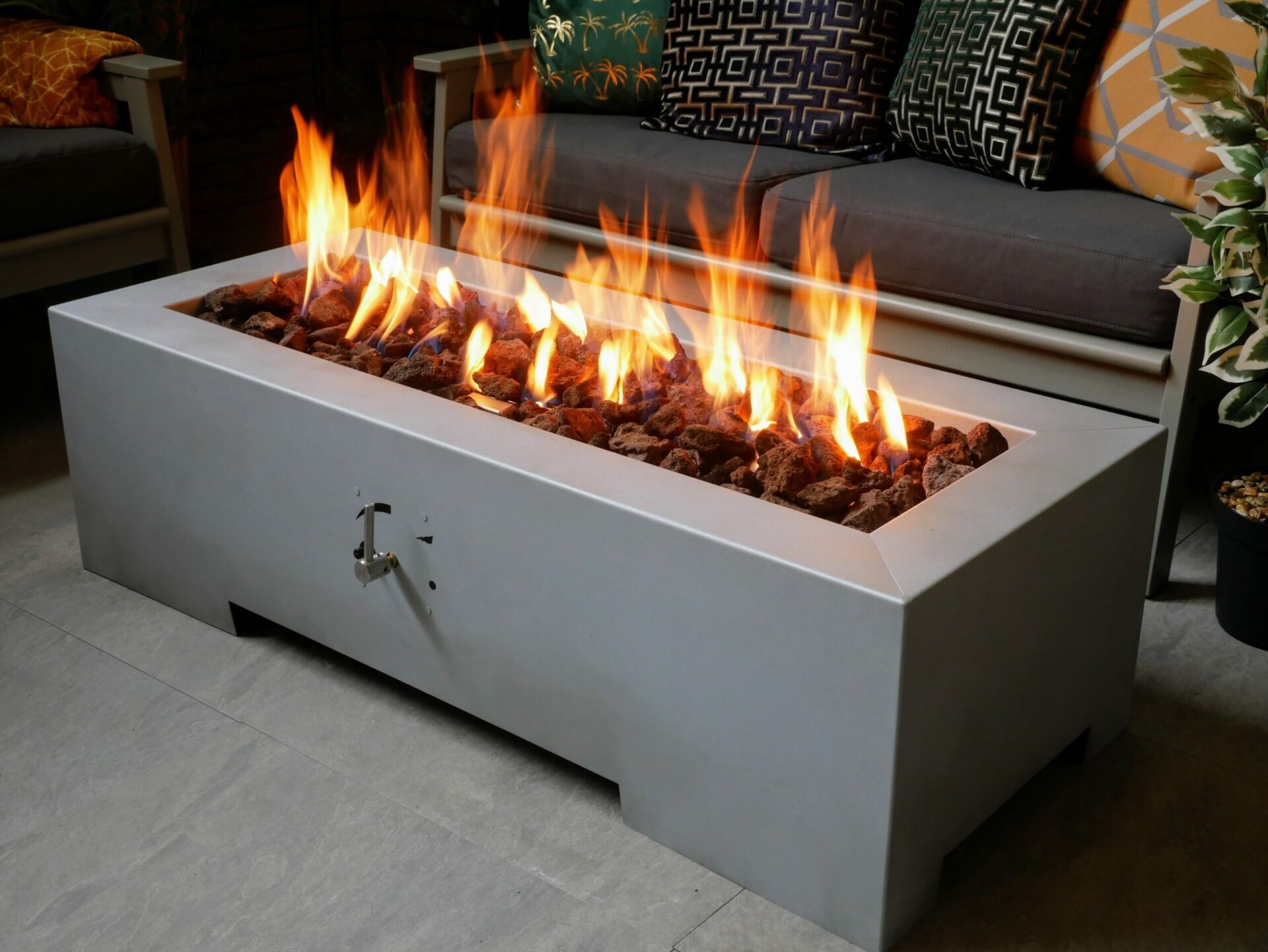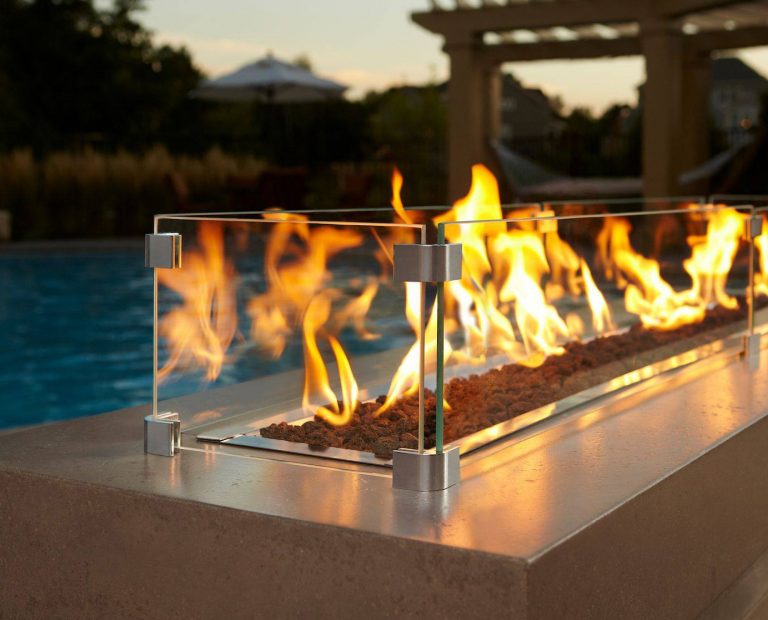Call us at 725-239-9966!
M-F: 8 AM-7 PM PST
Call us at 725-239-9966!
M-F: 8 AM-7 PM PST

Like any outdoor element, gas fire pits for outdoors require regular maintenance and cleaning to keep them looking pristine and operating safely. But cleaning your gas fire pit doesn't need to be a dreaded chore.
With the right techniques and a little elbow grease, you can have it looking like new in no time. This complete guide will walk you through the steps of cleaning various types of gas fire pits so you can keep yours in tip-top shape.
Always turn off the propane supply and let the fire pit cool completely before cleaning. Never hose down a hot fire pit.
Pay close attention to clearing debris from the burner ports and ignition system when cleaning. Use soft brushes and avoid abrasives.
Apply a metal protectant regularly to cast iron or steel fire pits to prevent rust. Cover the fire pit when not in use.
Deep clean neglected fire pits with gentle scrubbing, soaking, and rust removers. Persistence pays off for restoring heavily soiled fire pits.

Cleaning a gas propane fire pit is a simple task when armed with the right tools. Here’s what you’ll need:
Ensure to avoid abrasive scouring pads or harsh chemicals that could damage the fire pit finish. And before purchasing any new cleaning tools, refer to your owner's manual for the manufacturer's recommendations. You may also want to check out our fire pit buyer's guide to help select the right cleaning supplies for your specific model.

Follow these steps to thoroughly clean your fire pit and keep it in top shape:
Before doing any cleaning, make sure to turn off the gas supply to disable the fire pit. Verify the fire is completely out and allow ample time for the fire pit to cool. Attempting to clean the pit while hot can result in injury or damage.
Carefully remove all lava rocks, fire beads, or other decorative filler material from the fire pit. Place the rocks and glass beads into a bucket or large container to be cleaned separately later.
When removing the fire glass, make sure to inspect the base and burner for any debris that may have fallen through the glass like leaves, twigs, etc. Remove any debris right away.
Check the ignition ports on the burner for any blockages too and clean them out with a soft brush.
With the outdoor natural gas fire pit empty, focus on cleaning the burner and inner basin. Use a soft cloth to wipe away any debris or loose dirt. Then use a plastic brush, sponge, or scrub brush with mild soap and water to remove stubborn grease and grime buildup.
Be extremely gentle around the burner and gas line to avoid any damage. Rinse thoroughly with clean water.
When cleaning the burner, scrub away any carbon deposits or soot buildup. Make sure all the burner holes are cleared of debris as blockages can cause combustion issues.
Use a soft brush or plastic scraper to gently dislodge any chunks, spider webs, or debris on the burner. Avoid using metal tools.
For stuck-on debris, allow the burner to soak for 15-20 minutes in warm soapy water to loosen the grime before scrubbing.
Use a sponge and mild soap and water to scrub the entire interior surface of the fire pit. This will remove soot, ash, and other residue.
Rinse very thoroughly with clean water to remove all traces of soap and grime. Wipe with soft cloths until completely dry.
When cleaning the bowl, use a stiff scrub brush to remove any stubborn char or soot deposits.
Pay extra attention to the underside surface of the fire bowl as soot can collect there over time.
For stainless steel, buff the interior with a stainless steel cleaner and microfiber cloth after scrubbing to restore shine.
Check the base below the fire bowl for any debris or moisture and dry it out completely before relighting.
For cast iron, copper, or a large steel fire pit, apply a metal protectant to the entire exterior surface with a soft cloth. This prevents rust and adds shine. Allow to dry fully before use.
Stone or brick fire pits should be sealed with a masonry sealant for protection.
When applying metal protectant, rub it thoroughly into any crevices, holes, or etched designs where rust may form.
If there are any scratches or chips in the metal exterior, use a matching touch-up paint to prevent rust in damaged spots.
Once everything is fully dry, you can add back your lava rocks or fire glass beads. Rinse any excessively dirty rocks or glass separately before returning them to the pit. Top up with new filler material if needed.
Inspect each lava rock and fire glass bead. Discard any that are badly damaged or deteriorated. This will improve the overall look.
Consider adding new fire glass in a new color to change up the appearance. Arrange the glass evenly.
Only fill to 1-2 inches below the fire bowl rim so oxygen can easily circulate.

Cleaning frequency depends on how much you use your gas fire pit and the environment it lives in. Follow these general guidelines:
Clean at least once yearly before storing or covering for winter.
Clean as needed before and after your main fire pit season.
In damp climates, clean 2-3 times per year minimum.
With heavy use, clean 3-4 times a year or more.
Clean anytime debris, dirt, or rust accumulates. Don't let it build up.
Always clean after exposure to rain, sprinklers, storms, etc. so moisture doesn't linger.
Here is a helpful guide on recommended cleaning frequency:
| Usage | Environment | Cleaning Frequency |
|---|---|---|
| Light use | Dry climate | 1-2 times per year |
| Moderate use | Damp climate | 2-3 times per year |
| Heavy use | Any climate | 3-4 times per year |
| After rain/storms | Any climate | Clean ASAP after exposure |
The consequences of neglecting fire pit cleaning include reduced heat output, gas flow issues, damage from rust or cracks, and even potential hazards if gas ports get blocked. Stay on top of cleaning and your fire pit will thank you!
If you've neglected cleaning for too long, your gas fire pit may require some extra work. Here are some tips for deep cleaning a very dirty fire pit:
If rusty, mix lemon juice and baking soda to make a paste. Gently scrub rusted areas then rinse.
For stubborn deposits or soot in the basin, use a plastic putty knife to carefully scrape off.
If debris is compacted in the burner, use a pipe cleaner or thin wire brush to gently dislodge and clear ports.
Soak lava rocks in soapy water if greasy residue remains after rinsing.
For musty smells, sprinkle baking soda and leave overnight before rinsing clean.
Scrub stone or concrete with a stiff bristle brush and a mild cleaner.
Use a metal protectant on cast iron and steel fire pits after deep cleaning for added protection.
With some persistence and the right approach, even filthy neglected fire pits can be restored to like-new condition. Just be cautious not to damage any components in the process.
For quick reference, here are useful deep-cleaning solutions:
| Issue | Solution |
|---|---|
| Rust | Lemon juice and baking soda paste |
| Stubborn deposits | Plastic putty knife scrape |
| Compacted debris in the burner | Pipe cleaner or thin wire brush |
| Greasy residue on rocks | Soak in soapy water |
| Musty smells | Baking soda scrub |
| Stone/concrete stains | Stiff bristle brush and mild cleaner |


Keeping your gas fire pit in good condition requires regular cleaning and maintenance. Be sure to turn off the propane tank and allow ample time for the firepit to cool before wiping down the cast iron or metal fire pits with a damp cloth. Pay close attention to clearing any debris from the burner ports and ignition.
With consistent care and cleaning, your propane fire pit will provide warmth, ambiance, and beauty for years of enjoyable use. The small effort of fire pit maintenance will allow you to get the most out of your investment.
Yes, always ensure that you've disconnected the propane or natural gas line from your fire pit to avoid any fire hazards. Never douse a hot fire pit with water as a rapid change in temperature can cause cracking or damage, especially in a stone or brick fire pit. Lastly, never attempt to clean a fire pit that has not cooled completely.
For cast iron fire pits, you'll want to remove any remaining ash or debris until the inside is clear. Utilize a mixture of soap and water to clean the surface, and be sure to dry off your fire pit completely to prevent rusting. Using a cover for your fire pit when not in use is also a great way to protect it from the elements.
Regularly removing excess debris, keeping your gas line clean, and drying off your modern outdoor fire pit after it rains are essential in maintaining its longevity. It's also beneficial to keep your fire pit covered when it's not in use, protecting it from weathering and minimizing the effort to clean it prior to each use.
To clean the fire glass, you'll want to remove it from the fire pit and wash it with a mixture of one part vinegar to three parts water. After washing and rinsing, allow the fire glass to dry completely before returning it to the pit to prevent any water from mixing with the gas.
Regular cleaning and maintenance definitely help prevent rust and cracking. It's also important to dry your fire pit thoroughly after cleaning it and to cover it when not in use. Selecting fire pits made from rust-resistant materials or applying heat-resistant paint can also provide an extra layer of protection.
Regular cleaning, maintenance, and care, and using a cover can keep your backyard fire pit looking new. After using your fire pit, make sure to clear out the ash as it can absorb moisture and cause rust over time. Additionally, make sure your fire pit is completely dry before covering it up or putting it away to prevent rusting or cracking.
{"one"=>"Select 2 or 3 items to compare", "other"=>"{{ count }} of 3 items selected"}
Leave a comment